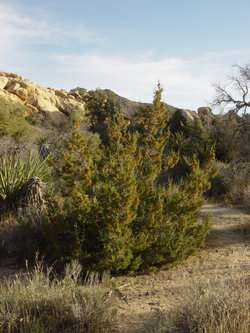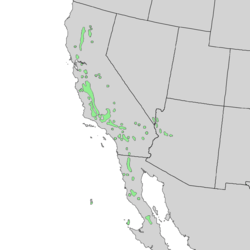Juniperus californica
| Juniperus californica | |
|---|---|
 | |
| In Joshua Tree National Park, California | |
| Scientific classification | |
| Kingdom: | Plantae |
| Division: | Pinophyta |
| Class: | Pinopsida |
| Order: | Pinales |
| Family: | Cupressaceae |
| Subfamily: | Cupressoideae |
| Genus: | Juniperus |
| Species: | J. californica |
| Binomial name | |
| Juniperus californica Carr. | |
 | |
| Natural range of Juniperus californica | |
 | |
Juniperus californica (California Juniper) is a species of juniper native to southwestern North America.
Distribution
As the name implies, it is mainly found in numerous California habitats, although its range also extends through most of Baja California, a short distance into the Great Basin in southern Nevada, and into northwestern Arizona. In California it is found in: the Peninsular Ranges, Transverse Ranges, California Coast Ranges, Sacramento Valley foothills, Sierra Nevada, and at higher elevation sky islands in the Mojave Desert ranges.
It grows at moderate altitudes of 750–1,600 metres (2,460–5,250 ft). Habitats include: Pinyon-Juniper Woodland with Single-leaf pinyon (Pinus monophylla); Joshua Tree Woodland; and Foothill Woodlands, in the Montane chaparral and woodlands and Interior chaparral and woodlands sub-ecoregions.
Description
Juniperus californica is a shrub or small tree reaching 3–8 metres (9.8–26.2 ft), but rarely up to 10 metres (33 ft) tall. The bark is ashy gray, typically thin, and appears to be "shredded".[1] The shoots are fairly thick compared to most junipers, between 1.5 and 2 millimeters (0.059 - 0.079 in.) in diameter.
Foliage is bluish-gray and scale-like. The leaves are arranged in opposite decussate pairs or whorls of three; the adult leaves are scale-like, 1 to 5 mm (0.039 - 0.20 in.) long on lead shoots and 1 to 1.5 mm (0.039 - 0.059 in.) broad. The juvenile leaves (on seedlings only) are needle-like, 5 to 10 mm (0.20 - 0.39 in.) long.
The cones are berry-like, 7 to 13 mm (0.28 - 0.51 in.) in diameter, blue-brown with a whitish waxy bloom, turning reddish-brown, and contain a single seed (rarely two or three).[1] The seeds are mature in about 8–9 months. The male cones are 2 to 4 mm (0.079 - 0.16 in.) long, and shed their pollen in early spring. It is largely dioecious, producing cones of only one sex, but around 2% of plants are monoecious, with both sexes on the same plant.[2]
It is closely related to Juniperus osteosperma (Utah Juniper) from further east, which shares the stout shoots and relatively large cones, but differs in that Utah Juniper is largely monoecious, its cones take longer to mature (two growing seasons), and it's also markedly more cold-tolerant.
Uses
Juniperus californica provides food and shelter for a variety of native ground and avian wildlife. It is a larval host for the native moth Sequoia sphinx (Sphinx sequoiae).[1]
Native Americans
The plant was used as a traditional Native American medicinal plant, and as a food source, by the indigenous peoples of California, including the Cahuilla people, Kumeyaay people (Diegueno), and Ohlone people.[3] They gathered the berries to eat fresh and to grind into meal for baking.[1]
Cultivation
Juniperus californica is cultivated as an ornamental plant, as a dense shrub (and eventual tree) for use in habitat gardens, heat and drought-tolerant gardens, and in natural landscaping design.[1] It is very tolerant of alkali soils, and can provide erosion control on dry slopes. California Juniper is also a popular species for bonsai.[4]
- Conservation
An IUCN Least concern listed species, and not considered globally threatened currently. However one of the southernmost populations, formerly on Guadalupe Island off the Baja California Peninsula coast, was destroyed by feral goats in the late 19th century.[5]
See also
- Juniperus macropoda (Pashtun Juniper)
References
Further reading
- Adams, Robert P. (1993): 10. Juniperus californica. In: Flora of North America Editorial Committee (eds.): Flora of North America North of Mexico vol. 2.
- Adams, Robert P. (2004): Junipers of the World: The genus Juniperus. Trafford Publishing ISBN 1-4120-4250-X
- Charters, Michael L. (2007): Wildflowers and Other Plants of Southern California: Juniperus californica. Retrieved 2007-OCT-16.
- Conifer Specialist Group (1998). Juniperus californica. 2006. IUCN Red List of Threatened Species. IUCN 2006. www.iucnredlist.org. Retrieved on 12 May 2006.
- León de la Luz, José Luis; Rebman, Jon P. & Oberbauer, Thomas (2003): On the urgency of conservation on Guadalupe Island, Mexico: is it a lost paradise? Biodiversity and Conservation 12(5): 1073–1082. doi:10.1023/A:1022854211166 (HTML abstract)
External links
- Calflora Database: Juniperus californica (California juniper)
- USDA Plants Profile for Juniperus californica (California juniper)
- Gymnosperm Database: Juniperus californica
- Juniperus californica — UC Photo gallery
| Wikimedia Commons has media related to Juniperus californica. |
